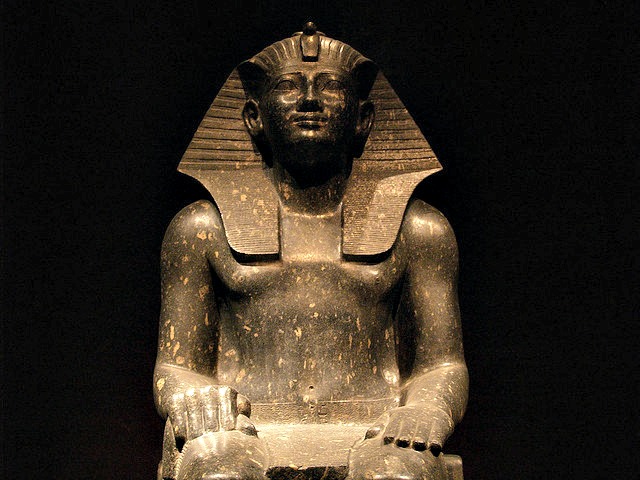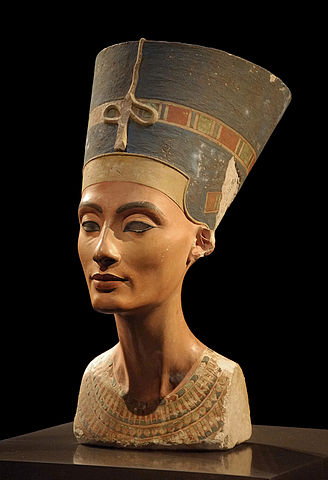Important People in Ancient Egypt.

1. Hatshepsut (1473 ‒ 1458 BC)

After the death of her husband Thutmose II, Hatshepsut ruled Egypt until the name heir, Thutmose III (son of Thutmose II), was old enough to take over. Hatshepsut was ambitious and declared herself the pharaoh of Egypt, stating that the god Amon-Ra said she was to be the pharaoh. After claiming the throne as pharaoh, Hatshepsut began to depict herself as a man in the traditional king’s clothing and crown, with a fake beard and male body. Though this may seem an effort to trick people, it was not! It was the way of asserting her authority as the female ruler. She ruled Egypt for twenty years and the nation prospered under her reign. Unlike other leaders, she focused on improving the economy and on building and restoring monuments instead of on fighting for new land. During her time in power, the nation’s economy was great. When Thutmose III claimed his throne, what became of Hatshepsut is a mystery.
2. Thutmose III (1479 ‒ 1425 BC)

Thutmose III never lost a battle and was a hero in ancient Egypt. He was greatly respected throughout Egypt. He was known for his valor, bravery and intelligence in battle, as well has for the many buildings he constructed. Despite being known as a great ruler, however, he might have been responsible for the disappearance of his stepmother, Hatshepsut. After Thutmose came into power, he tried to erase Hatshepsut’s name from history.
3. Tutankhamen (1336 ‒ 1327 BC)

Tutankhamen, better known today as King Tut, was the twelfth pharaoh of Egypt’s 18th Dynasty. He was crowned at the very young age of nine or ten. At birth, he was named Tutankhaten, which meant “the living image of Aten”, but later on it was changed to Tutankhamen, which meant “the living image of Amun”. During the first years of his reign, the country was probably ruled by an elder known as Ay. He is famous for his intact tomb that was discovered in the Valley of the Kings in Egypt in 1922. Despite his popularity today, he was only a minor figure in the history of Egypt.
The boy king ruled for approximately ten years and he died at the age of nineteen. After his death, he vanished from Egypt’s history and no information on him was found until the discovery of his tomb. Afterward, studies on his tomb revealed much of the information known today about King Tut. Many priceless valuables were found in Tutankhamen’s tomb, but the most intriguing discovery was the stone sarcophagus. Inside the stone sarcophagus, there were three coffins, one inside the other, and the final coffin was made of gold. In the final coffin, archaeologists found Tutankhamen’s royal mummy, preserved for more than three thousand years.
4. Ramses II (1279 ‒ 1213 BC)

Ramses the Great was the third pharaoh of the 19th Dynasty. His reign lasted 67 impressive years and he died at the age of ninety-two. He had outlived most of his family members, hence after his death, his thirteenth son, Merenptah, became his successor. Ramses had many wives and more than 100 children. Ramses II is regarded as one of the greatest rulers of Egypt. His reign was marked by the many battles he faced and he was known for his great military strength. Ramses II built many architectural structures, more than any other pharaoh in the history of Egypt. A significant number of his building achievements can still be found in Egypt today. The most notable structures built by him were the Ramesseum and the Temple of Abu Simbel.
5. Cleopatra VII

Cleopatra VII is perhaps the most famous of the female rulers of Egypt. Cleopatra was not an Egyptian — she came from Greek origins. She was a member of the Ptolemy family that had ruled Egypt for 100 years (starting with Alexander the Great after his conquest of Egypt). When Cleopatra became queen of Egypt, she as only eighteen years old and she had to rule along with her brother Ptolemy XIII. Later on, Ptolemy XIII forced Cleopatra from the throne and made himself the sole ruler of Egypt. Cleopatra was famous for her relationships, first with Julius Caesar and then with Mark Antony. With Caesar’s help she returned to power in Egypt, and had a son with him, named Caesarion. After Caesar’s murder, Cleopatra returned to Egypt and later on, she married Mark Antony. When he died, Cleopatra suicide by receiving a snakebite. Cleopatra was intelligent, clever and ambitious, and power hungry. She did not hesitate to use her great beauty to her advantage. Cleopatra VII was the last pharaoh of Egypt. After her death, Egypt came under the rule of Rome.
6. Nefertiti

Nefertiti was the wife of the Egyptian pharaoh Akhenaten, and was renowned for her beauty. Her name means “the beautiful one has come”. Both she and her husband worked hard to establish the Aten cult in Egypt. Previously, Egyptians had polytheistic religious beliefs (worshipping more than one god), but with Nefertiti and Akhenaten’s religious revolution, people were made to worship only one god — Aten the Sun God. Akhenaten displayed Nefertiti as an equal counterpart. She was perhaps one of the most powerful women in the history of Egypt. However, despite all her power, she disappeared from depictions after some years. The reason for her disappearance is unknown. Even her mummy has not been found.
To learn more about the Ancient Egyptians, see:




cracky
ummmmm didnt rlly help me at all lol
i no like
lol
it looks ok
yeet
This was a very informational article, it was quite helpful for my essay on ancient Egypt. Keep up the good work!
thanks a lot this helped me with a 2 page essay
wasssaaaaa helped THX
Lots of information- but needs more people..
thanks I really appreciate it 🙂
Very useful. A lot of new information ?
information
Wow… that was kind of helpful. However, it is not correct (as mentioned by Mrk), and there’s not enough for me to finish this stupid project
Doing project helped me alot I am doin a brochure.
what is this i can leave a comment what. (mind blown)
There are a few problems with this.
1. The mask of Tutankhamon is not the original.
2. The bust of Nefertiti is most likely a very early 20th century German fake.
There are many problems with the bust:
– one eye is missing, yet the bust is painted on
– the shoulders are cut vertically like on a mannequin, instead of horizontally as is standard
– the makeup is in Art Nouveau style
– the hardest to make parts are made of plaster
– the damage seems strategic rather than accidental
http://news.bbc.co.uk/2/hi/entertainment/arts_and_culture/8038097.stm
https://www.smithsonianchannel.com/videos/a-convicted-forger-calls-nefertitis-bust-a-fake/33471
thanks for your info you helped me succeed in my research project and I am actually genuine because without this sight I would have failed.
thanks for this it was very helpful! 🙂
did nice
This is pretty helpful but nothing I can use now.
Helped me a lot
doing a project and being weird
My name JEFF!
cool
I love this web page.
Thank you so much
cool stuf to learn
this is really helpful
Ok I guess.
Coolthough
nice sight
this is a good sight better than ducksters
yep
Rip Tutukaemon and this is some good facts
thanks 🙂
Those are some gucci facts
Dope
Copy paste
this is so dope
no
Cool ?